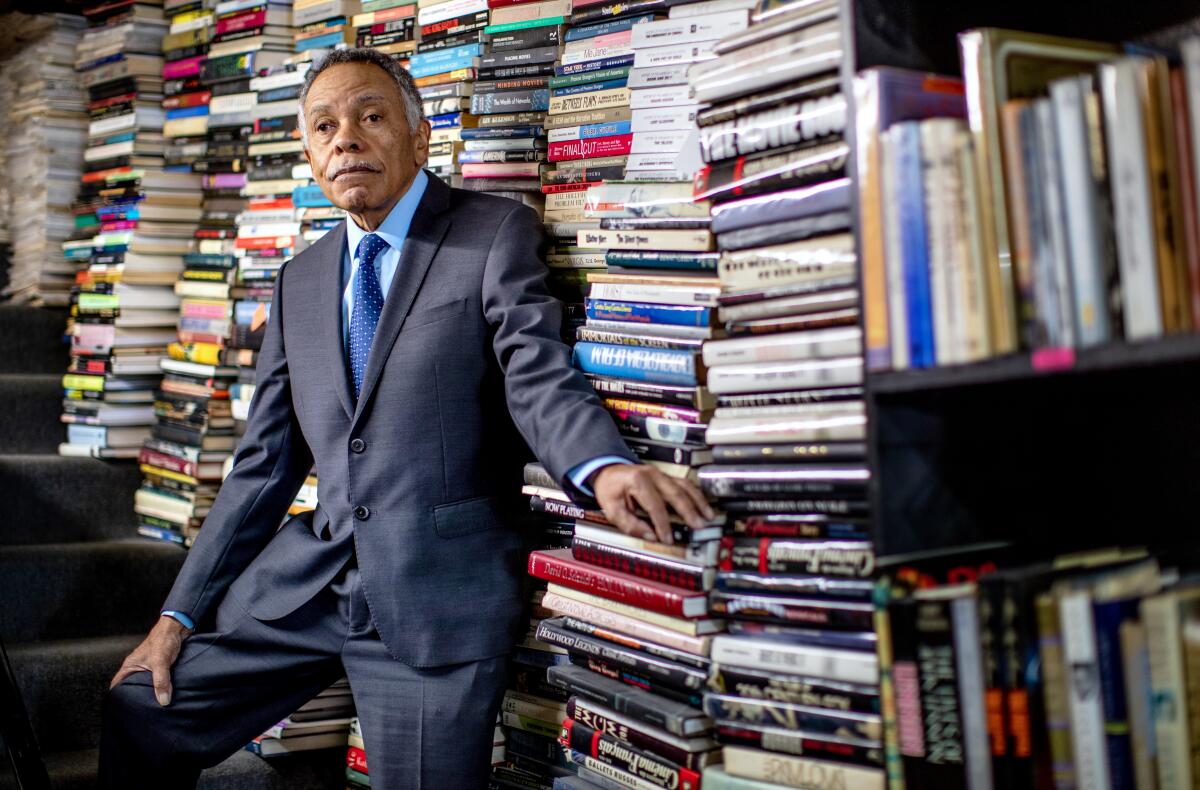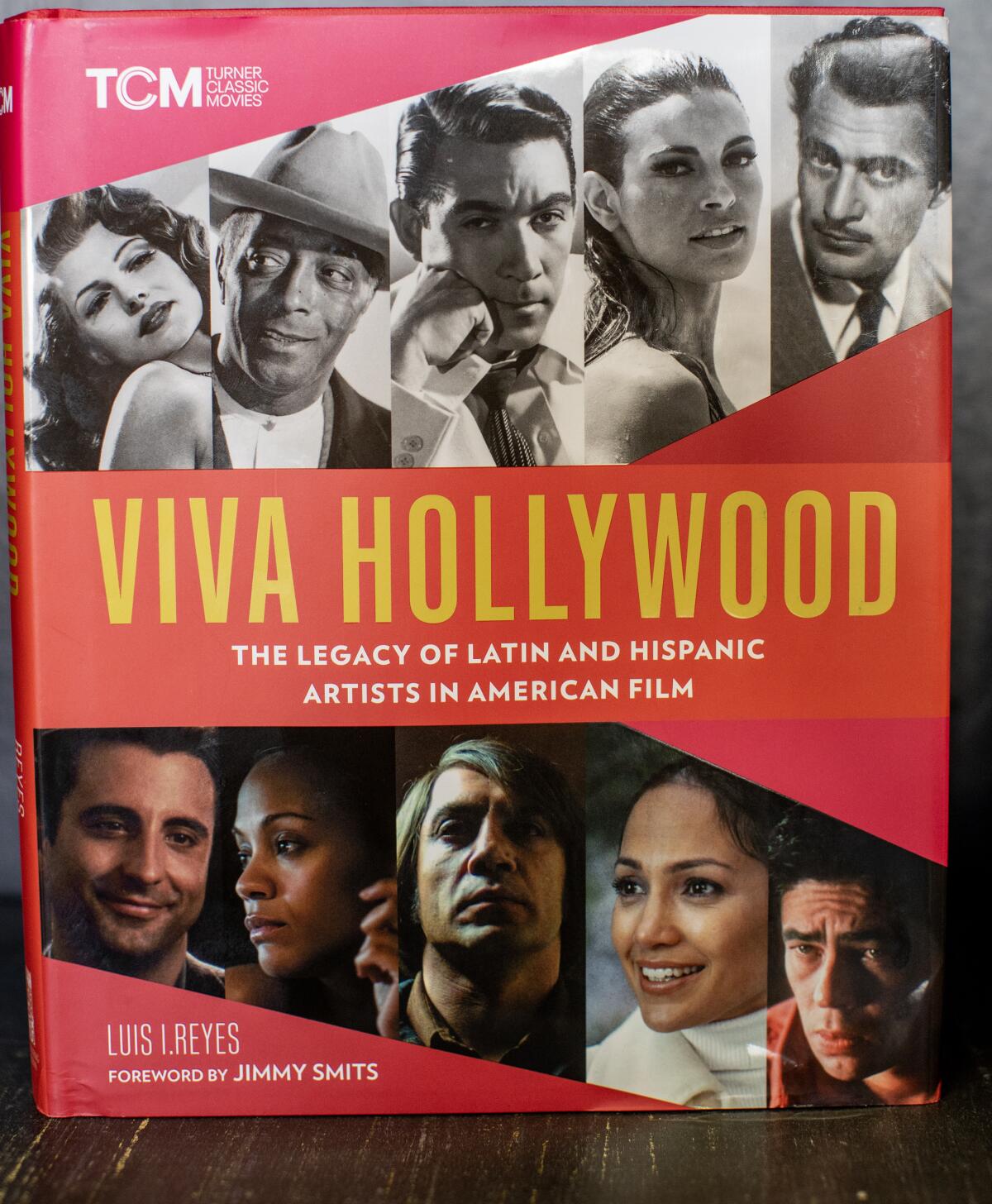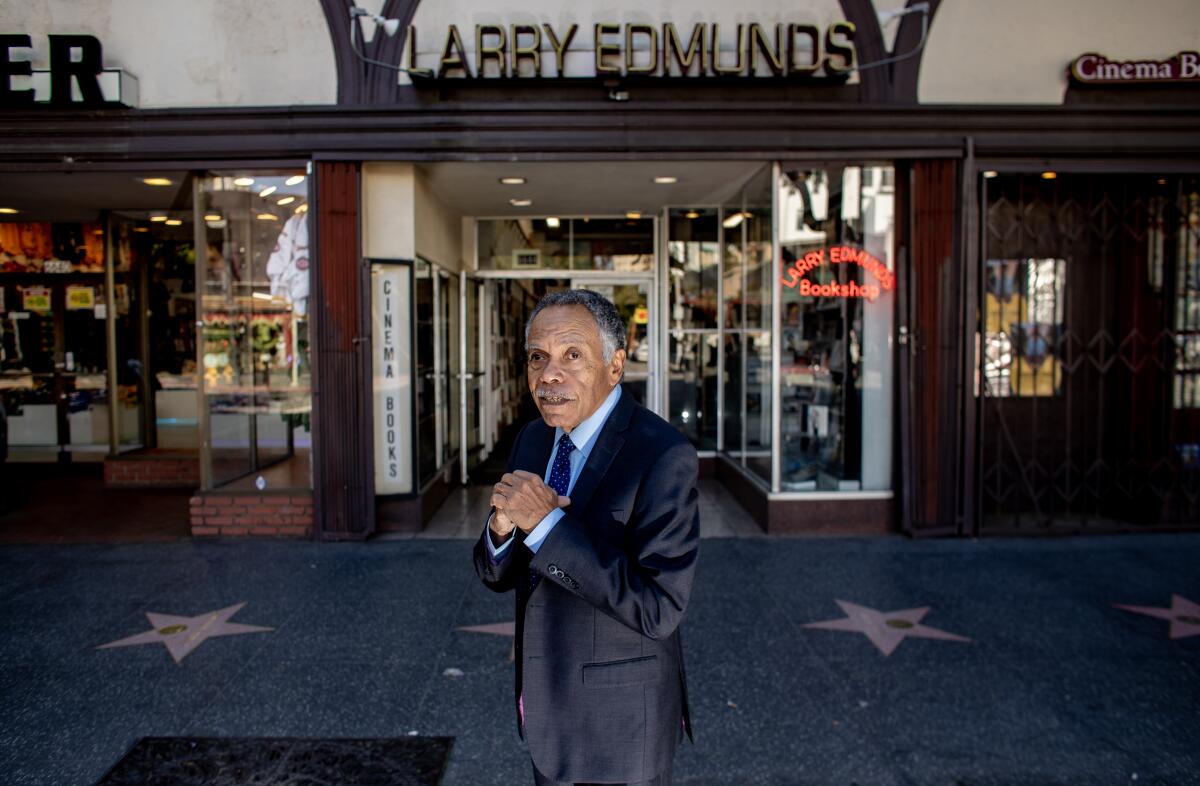Hollywood always had a Spanish accent, says Luis Reyes, but we need more Latino roles

- Share via
If Hollywood buffs want to jog their memory about the exact proportions of the Mexican water tank where James Cameron shot “Titanic,” Luis Reyes has the answer. If a Latina filmmaker seeks to brush up on her cinematic heritage, she can check out Reyes on TV critiquing Dolores del Rio’s and J. Lo’s most emblematic roles.
And if an #OscarsSoWhite activist demands to know why Charlton Heston — arguably the whitest actor in history — was cast in brownface to play a Mexican narcotics agent in “Touch of Evil,” and why there remains a scandalous shortage of Latinos in leading-man roles, Reyes might reply that ... well, it’s complicated.
Growing up in New York, the son of a Puerto Rican father and a Dominican mother, Reyes developed a lifelong liaison with darkened spaces. Decades later, he still can recount in granular detail the day that he saw “Planet of the Apes” at the Loews Capital on 52nd Street. He took in “Spartacus” at the DeMille on 7th Avenue at 47th. At his neighborhood theater, the Nemo (Broadway at West 110th Street), he rooted for John Wayne’s Captain Jake Cutter in “The Comancheros,” and he hooted at Jerry Lewis’ Nutty Professor at the Loews Olympia on 107th Street.
“When you live in New York you have the whole world at your feet, especially in Manhattan,” Reyes said over French dip sandwiches at Philippe one recent afternoon. He delivered these finely etched remembrances not through a haze of nostalgia, but as though he’d exited the movie house minutes before and couldn’t wait to tell a friend.
Closing in on 70, Reyes knows everybody and remembers everything about the movies, knowledge that he gleaned not only through countless afternoons in cushioned seats but through his extensive one-on-one interviews with actors, directors and writers and many years spent working as a publicist, hanging out on movie sets with everyone from Anthony Quinn to Salma Hayek and Mel Gibson.
Oh, the anecdotes! Just take him to Philippe some afternoon ....
He started writing about movies as a student at Bishop DuBois High School — you know, right there on 152nd Street? — and later for an organization called ASPIRA that assisted Puerto Rican students. (“We were all militant then. I was the head of the propaganda committee.”)
He dreamed of being an actor and snagged a few bit parts.
“But I found out I wasn’t that good an actor.” Plus, Hollywood folks didn’t think he “looked Mexican” enough. Actually, they didn’t think he looked Mexican at all.
“A lot of times people thought I was Black; they didn’t think I was Mexican. Because they didn’t have Dominicans at that time. In California, either you were a Mexican — and Mexicans looked a certain way.”
Then he took a friend’s suggestion to switch to publicity, and it was Lights! Camera! Career!
“The whole process of making movies interested me more than the acting part. To be a publicist you have to be nice with people, and you have to write notes for the movie, so it’s like a term paper. And you got to be on the set, and you got to see how it all came together from beginning to end, which later came in handy while writing the books.”

Authoritative, anecdote-rich and ardently written, Reyes’ books chronicle the all-too-obscure tale of the multitudes of Latinos, Latin Americans and a few Iberians who’ve shaped Hollywood since the silent era. Regarded as essential reference texts by students, academics and industry pros, they include “Made in Mexico,” “Hispanics in Hollywood” and his latest, the effusively illustrated “Viva Hollywood: The Legacy of Latin and Hispanic Artists in American Film” (Running Press/TCM).
They tell how silent screen idol Ramon Novarro — born José Ramón Gil Samaniego in Durango, Mexico — minted the archetype of the “Latin lover.” Why two Puerto Rican performers — first Rita Moreno, then Ariana De Bose — won Oscars playing Anita in the 1960 and 2021 versions, respectively, of “West Side Story.”
“We as Latinos did not work in a vacuum; we worked with everybody,” Reyes said. “We’re part of Hollywood history. We weren’t acknowledged, but we were there.”
And if you’ve pondered why Yalitza Aparicio won an Oscar for “Roma” but “really hasn’t done that much since” (Reyes’ words), or whether Tenoch Huerta’s career may follow a different trajectory after his “Black Panther: Wakanda Forever” breakout, Reyes can school you in the history of how the industry has gorged on fresh Latino talent while usually denying its members the second and third chances that it grants to actors, directors, writers, editors and cinematographers of lesser pigmentation.
But while Reyes, a kind and chivalrous fellow, has written eloquently and unsparingly about the discrimination that pervades Hollywood, “I didn’t want to dwell on that,” he said. “I wanted to dwell on the achievements.” His writings celebrate what is the most “American” of all art forms precisely because it was birthed by immigrants from everywhere.
Luis Valdez, the director, playwright and screenwriter who employed Reyes as a bad guy for a few scenes in his 1994 comedy-western “The Cisco Kid,” said Reyes’ books provide “a tremendous service for future generations” by showing the contributions Latinos have made to the film industry and the obstacles they’ve encountered and surmounted.
“I think he’s laid it out in a very clean way, the categories of stardom and the legacy going back to the silent days in Hollywood,” Valdez said. “And he’s done it without prejudicial anger, without being pissed about this or that. He’s not grinding an ax, he’s laying it out so that everybody can relate and come to their own conclusions.”
Producer Nancy De Los Santos-Reza, who got to know him while working together on Gregory Nava’s “Mi Familia” (1995), describes Reyes not only as a respected cultural interpreter but as a sort of one-man diplomatic corps in a business where ruthless self-interest often rules.
“When you meet somebody who is trustworthy and honest and kind-hearted, you really pay attention. And that’s what he is,” said De Los Santos-Reza, whose next film is the romantic comedy “The Answer to My Prayer.”

As for Reyes’ authorial output, she compares him to the late Chicago film critic Roger Ebert, who fashioned a Pulitzer Prize-winning style that was unshowily erudite and went down smooth.
“Go read Luis to understand the heart and soul of our community of artists,” she said. “And go ask Luis out to dinner and just have him talk to you about the movies.”
Actor Pepe Serna, who worked with Reyes half a lifetime ago on “Walk Proud,” said that his friend’s encyclopedic knowledge and personal relationships connect Latino film artists across generations and regions.
“He’s the bridge between the old timers and now,” said Serna, whose overflowing filmography ranges from Roger Corman’s “The Student Nurses” to “Scarface” and Eva Longoria’s “Flamin’ Hot.”
“He’s from New York, so he’s also a bridge from East Coast to West Coast.”
Reyes knows better than practically anyone how Hollywood still keeps its drawbridge half-raised to Latinos trying to enter the magic kingdom. In decades past, Latinos were hired to play all kinds of roles: Native Americans, Arabs, you name it. And many of the “Latino” roles were crude, reductive and racist. Too many still are.
“There was one guy, he worked so often as a bandito that he had his own bandito costume. Because they paid you more if you brought your own costume,” Reyes said. “Some people didn’t mind stereotypes because it was work.”
Reyes believes that “an actor is an actor and should be allowed to play any role he can believably play and that his talents allow him to, and that audiences will accept.” The problem, as he sees it, is that Latinos and Latinas don’t get equal opportunity to fill leading roles and other marquee technical posts on ambitious, artistic films or big-budget blockbusters.
“And it becomes a self-fulfilling prophesy: ‘Oh, there are no Latino leading actors.’”
Still, Reyes was heartened by this year’s Oscar contestants like Ana De Armas, Guillermo del Toro and “Argentina, 1985,” and for the multiple accolades accorded to “Everything Everywhere All at Once.” He’s looking forward to upcoming feature films with Cheech Marin and Esai Morales, among many others. He’s encouraged at the way TV, streaming and other platforms are giving Latinos more shots at employment. And you can catch him April 16 at the Hollywood Legion Theater, where he’ll moderate a Q&A after a special screening with Edward James Olmos and Lou Diamond Phillips of Ramón Menéndez’s “Stand and Deliver” (1988) as part of the TCM Classic Film Festival.
Though he’s not ready to stop writing, he may ride off into the sunset someday to visit Rome and Paris, then take the train to Barcelona, Granada … .
“Because I want to go to Almería. Where they shot all the spaghetti westerns, of course.”
And he wants to revisit Durango, which body-doubled for many Hollywood westerns, their gunshots and brash gringo accents ringing out across the arid Mexican plains.
“It’s cowboy country, John Wayne. I always say, ‘La tierra de Pancho Villa y de John Wayne!’’”
More to Read
The biggest entertainment stories
Get our big stories about Hollywood, film, television, music, arts, culture and more right in your inbox as soon as they publish.
You may occasionally receive promotional content from the Los Angeles Times.










